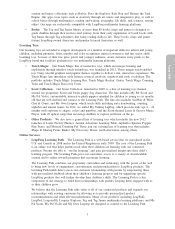LeapFrog 2012 Annual Report Download - page 21
Download and view the complete annual report
Please find page 21 of the 2012 LeapFrog annual report below. You can navigate through the pages in the report by either clicking on the pages listed below, or by using the keyword search tool below to find specific information within the annual report.
supply of components or if prices rise significantly, we may be unable to manufacture sufficient quantities of
our finished products or we may be unable to manufacture them at targeted cost levels, and our business and
operating results could be harmed.
We rely on a limited number of manufacturers to produce our finished products, and our reputation
and operating results could be harmed if they fail to produce quality products in a timely and
cost-effective manner and in sufficient quantities or if our manufacturing process is otherwise disrupted.
We outsource substantially all of our manufacturing to a limited number of Asian manufacturers, most of
which manufacture our products at facilities in the Guangdong province in the southeastern region of China.
We depend on these manufacturers to produce sufficient volumes of our finished products in a timely fashion,
at satisfactory cost and quality levels, and in accordance with our and our customers’ terms of engagement. If
we determine that we need to order larger quantities of our products to meet customer demand, we may
encounter delays and shortfalls in shipments based on manufacturer capacity issues. In addition, the costs of
using contract manufacturers are subject to increase, which has had, and could continue to have, a negative
impact on our cost of sales. Economic and other factors that adversely affect these manufacturers may also
adversely affect us. For example, labor costs in China continue to increase due to a variety of factors,
including tightening Chinese labor markets and the revaluation of Chinese currency to permit it to rise in
value versus the U.S. dollar, leading to increased prices for us with some of our contract manufacturers.
Furthermore, in the past, there have been product quality and safety issues for other producers of toys and
other companies that manufacture goods in China. In addition, the risk of political instability and civil unrest
exists in China, which could temporarily or permanently damage our manufacturing operations located there.
See also ‘‘Political developments, changes in trade relations, the threat or occurrence of armed hostilities,
terrorism, labor strikes, natural disasters or public health issues could have a material adverse effect on our
business’’ below. If our manufacturers fail or are unable to produce quality finished products on time, at
expected cost targets and in sufficient quantities, or if any of our products are found to be tainted or otherwise
raise health or safety concerns, our reputation and operating results would suffer.
If we do not maintain sufficient inventory levels or if we are unable to deliver our products to our
customers in sufficient quantities, or on a timely basis, or if inventory levels are too high, our operating
results will be adversely affected.
The high degree of seasonality of our business places stringent demands on our inventory forecasting and
production planning processes. This inventory management approach may be particularly challenging when
combined with ‘‘just-in-time’’ inventory management systems commonly used by retailers to minimize their
inventory levels. If we fail to meet tight shipping schedules, we could damage our relationships with retailers,
increase our shipping costs or cause sales opportunities to be delayed or lost. In order to be able to deliver our
merchandise on a timely basis, we need to maintain adequate inventory levels of the desired products. If our
inventory forecasting and production planning processes result in our manufacturing inventory in excess of the
levels demanded by our customers, we could be required to record inventory write-downs for excess and
obsolete inventory, which would adversely affect our operating results. In addition, if our processes result in
our inventory levels being too low to meet customer demand, we may lose sales.
If we are unable to maintain or acquire licenses to include intellectual property owned by others in our
games, our operating results will suffer.
Among our proprietary rights are inbound licenses from third parties for content such as characters, stories,
music, illustrations and trade names, and for technologies we incorporate in our products including key
technology used in our Tag and Tag Junior reading systems. In particular, we rely on our ability to acquire
rights to popular entertainment media properties for content on our multimedia learning platforms. Our
continued use of these rights is dependent on our ability to continue to obtain these license rights and at
reasonable rates. Any failure to do so could significantly impact our content sales or interrupt our supply chain
and require us to modify our products or business plans.
13
























